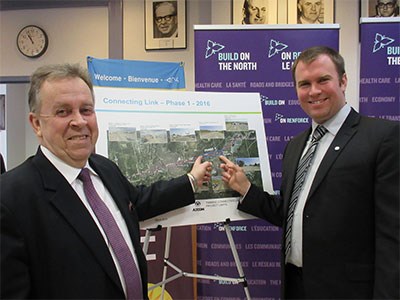Notorious for its crater-sized potholes and heavy traffic, Algonquin Boulevard in Timmins — which doubles as provincial Highway 101 — will finally get some relief this summer with the start of a $95.5-million reconstruction project.
In February, engineering firm AECOM presented city council with a preliminary design study that details the work that needs to be done on the 21.2-kilometre stretch of road, along which about 25,000 vehicles travel daily.
After years of neglect — in part because of a lack of available funding — Timmins Mayor Steve Black said he wasn’t surprised at the hefty price tag.
“We knew it was going to be a very large project and definitely up in the tens of millions of dollars, so I won’t say it was shocking or anything,” Black said. “We knew it was going to be probably the largest construction project we’ve done in quite some time.”
The extensive plan includes replacing underground infrastructure, repaving, and improving traffic flow in areas that tend to become more congested during peak hours.
The project got a welcome boost on March 31 when the province announced Timmins would receive $3 million through the Connecting Links program — the largest available amount through the provincial funding initiative.
The money will be used to reconstruct a 2-kilometre section of the road running east from Bruce Avenue.
The Connecting Links program will make available $20 million in 2016-2017, $25 million in 2017-2018, and $30 million per year by 2018-2019.
Black called the Timmins announcement “great news,” which will help get the 10-year, 10-phase reconstruction project started.
“Our phase one of the project is going be a $4.5-million project, so to get $3 million from the province will cover about two-thirds of the project, and we’ll cover the final third of the project,” he said.
“Obviously, we still have a lot more to go, with another $90-million-plus on the table, to still solve how we’re going to finance and try to come to some sort of long-term partnership with the upper levels of government for funding.”
Because the reconstruction work had been put off for so long, replacement of much of the infrastructure is crucial at this point, and it’s unlikely the project can be whittled down to a more manageable level, Black said.
The $95.5-million project includes the very base amount of construction required; add-ons that were suggested as part of a “wish list” brings the project total up to the $140-million range.
“I would say the vast majority of our residents use (the road) on a day-to-day basis, so it’s at the age where it needs to be reconstructed, and there’s not a whole lot longer we can put it off,” he said.
In the past, Black had been critical of the limited funding the province was providing after the original Connecting Link program was cancelled in 2013. At the time, the province had set aside $15 million per year to spread across 350 kilometres of roads and 70 bridges along connecting links in 77 municipalities.
Even before the program was cancelled, the funding provided was only enough to do routine maintenance and didn’t allow for major reconstruction-type projects, Black said. And it’s difficult for the city to plan its reconstruction strategy when it’s unsure if it’s getting funding at all, he added.
But citing positive relationships with Transportation Minister Steven Del Duca and Northern Development and Mines Minister Michael Gravelle, Black said he was optimistic about future funding allotments for the road, which provides an essential link for residents, who need to get to jobs and medical appointments in other jurisdictions.
“We feel good with the discussions that have taken place, and we’re happy that there’s a partner there,” he said. “They’ve stepped up to start phase one, and we look forward to addressing the other nine phases.”
After presenting the phased reconstruction plan to council in February and the general public in March, AECOM is now preparing detailed engineering plans for phase one. Construction is slated to start this summer.




